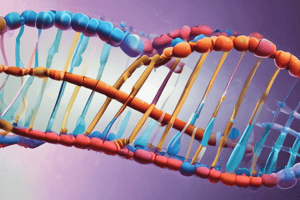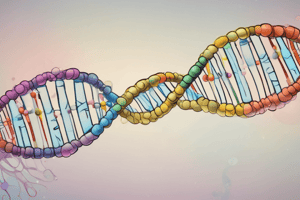Podcast
Questions and Answers
What is the type of DNA replication model that states each parent strand is incorporated into a new double-stranded DNA molecule?
What is the type of DNA replication model that states each parent strand is incorporated into a new double-stranded DNA molecule?
- Semiconservative (correct)
- Liberal
- Conservative
- Radical
What is the point of separation of the two strands of DNA called?
What is the point of separation of the two strands of DNA called?
- Replication origin
- Replication fork (correct)
- Topoisomerase
- DNA helicase
What enzyme is responsible for breaking the H-bonds between base pairs during DNA replication?
What enzyme is responsible for breaking the H-bonds between base pairs during DNA replication?
- Topoisomerase
- DNA polymerase III
- RNA primase
- DNA helicase (correct)
What is the purpose of RNA primers in DNA replication?
What is the purpose of RNA primers in DNA replication?
What is the purpose of DNA ligase in DNA replication?
What is the purpose of DNA ligase in DNA replication?
What is the main function of topoisomerases during DNA replication?
What is the main function of topoisomerases during DNA replication?
Which type of DNA strand is built in a continuous fashion by DNA polymerase III?
Which type of DNA strand is built in a continuous fashion by DNA polymerase III?
What is the direction of DNA synthesis on the leading strand?
What is the direction of DNA synthesis on the leading strand?
What is the primary function of DNA polymerase I during DNA replication?
What is the primary function of DNA polymerase I during DNA replication?
What is a characteristic of DNA replication in prokaryotes?
What is a characteristic of DNA replication in prokaryotes?
Flashcards are hidden until you start studying
Study Notes
Semiconservative Model of DNA Replication
- Each parent strand of DNA is incorporated into a new double-stranded DNA molecule.
- This model was proven by experiments conducted by Meselson and Stahl.
DNA Replication Process
Step 1: Strand Separation
- DNA must "unzip" using an enzyme called DNA helicase, which breaks the H-bonds between base pairs starting at the replication origin.
- The point of separation of the two strands of DNA is called the replication fork.
- Tension in the unwinding strand is relieved by topoisomerases, which cleave one or two of the DNA strands, allowing them to untwist, then rejoin the strands.
- The strands are kept apart by single-stranded binding proteins (SSBs).
Step 2: Building Complementary Strands
- The leading strand is built in a continuous fashion by DNA polymerase III by adding nucleoside triphosphates onto the 3' end of the parent strand.
- New DNA is assembled 5' to 3'.
- Replication starts when RNA primase puts down a 'starting point' - RNA primer (about 10 to 60 RNA ribonucleotides long).
- Only one primer is needed for the leading strand, and it is built continuously toward the replication fork.
- The lagging strand is built away from the replication fork in short fragments called Okazaki fragments by DNA Polymerase III.
- RNA primers are continuously added to the 5' end of the new strand (or the 3' end of the parent strand).
- DNA polymerase I removes the RNA primers and replaces them with DNA nucleotides (while also proofreading the strands).
- Okazaki fragments are connected by DNA ligase by creating phosphodiester bonds between nucleotides.
Step 3: Dealing with Errors during Replication
- DNA polymerase I and III proofread new strands.
- DNA polymerase II repairs damage to DNA, including damage that occurs between replication events.
DNA Replication in Prokaryotes and Eukaryotes
- Prokaryotic genomes are much smaller and usually contain just one replication bubble.
- Eukaryotic DNA is very long and linear, therefore thousands of replication bubbles can appear.
Semiconservative Model of DNA Replication
- Each parent strand of DNA is incorporated into a new double-stranded DNA molecule.
- This model was proven by experiments conducted by Meselson and Stahl.
DNA Replication Process
Step 1: Strand Separation
- DNA must "unzip" using an enzyme called DNA helicase, which breaks the H-bonds between base pairs starting at the replication origin.
- The point of separation of the two strands of DNA is called the replication fork.
- Tension in the unwinding strand is relieved by topoisomerases, which cleave one or two of the DNA strands, allowing them to untwist, then rejoin the strands.
- The strands are kept apart by single-stranded binding proteins (SSBs).
Step 2: Building Complementary Strands
- The leading strand is built in a continuous fashion by DNA polymerase III by adding nucleoside triphosphates onto the 3' end of the parent strand.
- New DNA is assembled 5' to 3'.
- Replication starts when RNA primase puts down a 'starting point' - RNA primer (about 10 to 60 RNA ribonucleotides long).
- Only one primer is needed for the leading strand, and it is built continuously toward the replication fork.
- The lagging strand is built away from the replication fork in short fragments called Okazaki fragments by DNA Polymerase III.
- RNA primers are continuously added to the 5' end of the new strand (or the 3' end of the parent strand).
- DNA polymerase I removes the RNA primers and replaces them with DNA nucleotides (while also proofreading the strands).
- Okazaki fragments are connected by DNA ligase by creating phosphodiester bonds between nucleotides.
Step 3: Dealing with Errors during Replication
- DNA polymerase I and III proofread new strands.
- DNA polymerase II repairs damage to DNA, including damage that occurs between replication events.
DNA Replication in Prokaryotes and Eukaryotes
- Prokaryotic genomes are much smaller and usually contain just one replication bubble.
- Eukaryotic DNA is very long and linear, therefore thousands of replication bubbles can appear.
Studying That Suits You
Use AI to generate personalized quizzes and flashcards to suit your learning preferences.




